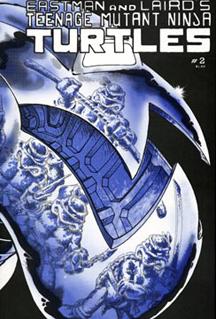After the breakthrough debut issue of Mirage “Teenage Mutant Ninja Turtles” Volume 1, the next few issues show what writers/artists Kevin Eastman and Peter Laird are good at, and what they are not so good at. And for people like me who initially knew the Turtles via the 1990 movie and 1987-96 cartoon, Issues 2-4 (1984-85) show the genesis of more core TMNT concepts: April meeting the Turtles, the mousers, Splinter’s disappearance and TCRI (TGRI in the second movie).
Fun, but immature
First, I’ll mention what Eastman and Laird don’t do so well at this early stage: They aren’t complex plotters. The action moves forward in a fast-paced but immature fashion that’s filled with contrivances. Splinter escapes the mousers but is picked up during a routine patrol of the sewers by the aliens of TCRI (Techno Cosmic Research Industries, we’ll later learn), which just happens to be the company that created the mutagen ooze.
The Turtles go out to catch some night air, and they just happen to see the TCRI building. And they just happen to run into Splinter while seeking answers about their origin.

“Teenage Mutant Ninja Turtles” Issues 2-4 (1984-85)
Titles: “TMNT vs. the Mousers” (No. 2), “The Great Chase” (No. 3), “Rescuing Master Splinter” (No. 4)
Writers: Kevin Eastman and Peter Laird
Pencils: Kevin Eastman and Peter Laird
Inks: Kevin Eastman and Peter Laird
E&L fall short of originality with their first post-Shredder villain, too: Baxter Stockman is a mad scientist who literally cackles maniacally. His assistant, April (an insecure young tech programmer, not a TV reporter), points out that he could become rich by selling his mousers to city governments in an above-board manner rather than threatening to use them to chew up buildings’ foundations. (Among Baxter’s targets is the World Trade Center; remember, this was 1984).
Baxter replies: “You’re quite right, April. The money is only an incidental by-product. I’m really doing it because it’s fun! Hah, hah, ha, hah!” Eastman and Laird’s storytelling at this point is on par with the short stories I’d write in high school while bored in class. They starred my friends, and the adventures were based on movie and TV clichés.
On the other hand, I do like the way April immediately befriends the Turtles and Splinter in an almost childlike fashion. The bond might come from the fact that she (as a surrogate for the comic-book-geeks who love TMNT) feels like an outsider just like they do.
Conveniently, she lives in a building that’s completely condemned with the exception of her nice apartment and the Second Time Around antique shop she inherited from her father, and it gives the Turtles a safe haven after the destruction of their lair by mousers (and the subsequent investigation of the sewer tunnel by cops).
Art tells the story
Eastman and Laird’s true strengths are as artists more so than scripters; they’re so good that the art substantially helps tell the story. Looking at their detailed panels of urban sprawl, it puts me smack dab in New York City, even though I’ve never been there (and E&L weren’t from there, either, as they created these comics in Northampton, Mass.).
The van chase in Issue 3 is insanely contrived – April’s van just happens to be identical to one used in a robbery, so the police chase them. Then they get away by running into and flipping over the actual van the police were looking for! Yet it does nicely illustrate the Turtles’ fear of being captured by “those who would be our allies,” and it also shows how chaotic the streets of NYC can be.
Other parts of the city (like April’s building) are vacant enough to achieve an urban-wasteland beauty like one would see in “Escape from New York.” (The first TMNT movie did a wonderful job at portraying the city, too.) Throw in the Turtles’ sewer lair and – intentionally or not – E&L create sprawling, grimy NYC that’s the main reason I love perusing these old comics.
I also like how E&L draw the Turtles. Other Mirage artists will go on to do a fine job, too, but many artists at Image and IDW draw the Turtles too ugly. Here, E&L draw cutely aggressive Turtles, with their noses jutting over their grimacing, teeth-bearing mouths. To me, that’s what they’re supposed to look like, at least as a foundation; E&L will expand their library of Turtle expressions as the story goes forward.
Shaping personalities, mythology
We get characterization in these early books, too. Leonardo leads, but not necessarily well; Raphael storms off to look for Splinter while Leo commands everyone to start packing up their essentials to clear out and flee to April’s.
Michaelangelo (yes, the Renaissance painter’s name is misspelled here) is Raph’s best bud; they enjoy sparring – but he certainly lacks Raph’s edge. And Donatello is inclined toward gadgets; in Baxter’s lab, Don assists April in working on the master control computer while the other three battle encroaching mousers.
In Issue 4, we get another classic concept: the TCRI aliens (Utroms, as we’ll later learn) — brains inside robot shells, with a fake human skin they can drape over it – are obviously the inspiration for Krang, the main villain of the cartoon. Here, though, they aren’t necessarily evil.
They even seem to be nursing Splinter back to health. The Turtles bungle their way onto the platform of the aliens’ transmat machine (like the time machine in the “Terminator” franchise), which blasts them to another planet for Issue 5.
From what I’ve read over at TMNT Entity, the gritty street fights are Eastman’s, the pulp sci-fi intrigue is Laird’s. While the expansion of the mythology is important for telling long-running stories, I prefer what Eastman brings to the table. (By analyzing their solo work, TMNT Entity concludes, quite rightly, that E&L are much better together than each on his own.)
Room to grow
Whether it’s intentional or an effect of the “throw it at the wall” approach to storytelling, I like how the Turtles are nowhere near fully formed superheroes at this point. It makes sense, because they are 15-year-olds who have only battled the Foot Clan twice and who don’t know their purpose in the world. It’s an issue we all face. Certainly, April’s going through it; she’s not merely unengaged by her tech job — her boss tried to kill her!
But the modern American human world is structured enough that many decisions are made for us; clearly, that’s not the case if you’re a mutant turtle. After hearing the origin story, April asks: “What will you do now? What purpose will inspire your lives now?” Splinter says: “That is a very good question, April. It depends mostly on what my students …” He’s interrupted by the news broadcast about Baxter’s terrorist threat.
April’s question will hang like a shadow over future, more spiritual Mirage yarns, but it’s answered here on a literal level: The Turtles will fight crime where they find it in the Big Apple. And once they start on that journey, they’ll go wherever random chance (or Laird’s latest wacky sci-fi idea) takes them.


